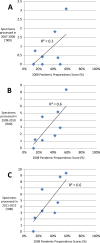Improvements in pandemic preparedness in 8 Central American countries, 2008-2012
- PMID: 24886275
- PMCID: PMC4022548
- DOI: 10.1186/1472-6963-14-209
Improvements in pandemic preparedness in 8 Central American countries, 2008-2012
Abstract
Background: In view of ongoing pandemic threats such as the recent human cases of novel avian influenza A(H7N9) in China, it is important that all countries continue their preparedness efforts. Since 2006, Central American countries have received donor funding and technical assistance from the U.S. Centers for Disease Control and Prevention (CDC) to build and improve their capacity for influenza surveillance and pandemic preparedness. Our objective was to measure changes in pandemic preparedness in this region, and explore factors associated with these changes, using evaluations conducted between 2008 and 2012.
Methods: Eight Central American countries scored their pandemic preparedness across 12 capabilities in 2008, 2010 and 2012, using a standardized tool developed by CDC. Scores were calculated by country and capability and compared between evaluation years using the Student's t-test and Wilcoxon Rank Sum test, respectively. Virological data reported to WHO were used to assess changes in testing capacity between evaluation years. Linear regression was used to examine associations between scores, donor funding, technical assistance and WHO reporting.
Results: All countries improved their pandemic preparedness between 2008 and 2012 and seven made statistically significant gains (p < 0.05). Increases in median scores were observed for all 12 capabilities over the same period and were statistically significant for eight of these (p < 0.05): country planning, communications, routine influenza surveillance, national respiratory disease surveillance, outbreak response, resources for containment, community interventions and health sector response. We found a positive association between preparedness scores and cumulative funding between 2006 and 2011 (R2 = 0.5, p < 0.01). The number of specimens reported to WHO from participating countries increased significantly from 5,551 (2008) to 18,172 (2012) (p < 0.01).
Conclusions: Central America has made significant improvements in influenza pandemic preparedness between 2008 and 2012. U.S. donor funding and technical assistance provided to the region is likely to have contributed to the improvements we observed, although information on other sources of funding and support was unavailable to study. Gains are also likely the result of countries' response to the 2009 influenza pandemic. Further research is required to determine the degree to which pandemic improvements are sustainable.
Figures




References
-
- WHO International Health Regulations. 2005. [ http://www.who.int/ihr/publications/9789241596664/]
-
- World Health Organisation. WHO World now at the start of 2009 influenza pandemic. 2009.
-
- Dawood FS, Iuliano AD, Reed C, Meltzer MI, Shay DK, Cheng PY, Bandaranayake D, Breiman RF, Brooks WA, Buchy P, Feikin DR, Fowler KB, Gordon A, Hien NT, Horby P, Huang QS, Katz MA, Krishnan A, Lal R, Montgomery JM, Mølbak K, Pebody R, Presanis AM, Razuri H, Steens A, Tinoco YO, Wallinga J, Yu H, Vong S, Bresee J. et al.Estimated global mortality associated with the first 12 months of 2009 pandemic influenza A H1N1 virus circulation: a modelling study. Lancet Infect Dis. 2012;14(9):687–695. doi: 10.1016/S1473-3099(12)70121-4. - DOI - PubMed
MeSH terms
LinkOut - more resources
Full Text Sources
Other Literature Sources
Medical

